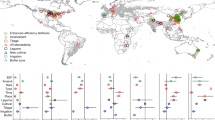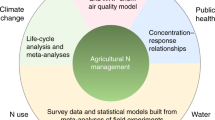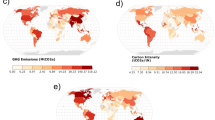Abstract
Food security relies on nitrogen fertilizers, but its production and use account for approximately 5% of global greenhouse gas (GHG) emissions. Meeting climate change targets requires the identification and prioritization of interventions across the whole life cycle of fertilizers. Here we have mapped the global flows of synthetic nitrogen fertilizers and manure and their corresponding GHG emissions across their life cycle. We have then explored the maximum mitigation potential of various interventions to reduce emissions by 2050. We found that approximately two-thirds of fertilizer emissions take place after their deployment in croplands. Increasing nitrogen-use efficiency is the single most effective strategy to reduce emissions. Yet this should be combined with decarbonization of fertilizer production. Using currently available technologies, GHG emissions of fertilizers could be reduced up to approximately one-fifth of current levels by 2050.
This is a preview of subscription content, access via your institution
Access options
Access Nature and 54 other Nature Portfolio journals
Get Nature+, our best-value online-access subscription
$29.99 / 30 days
cancel any time
Subscribe to this journal
Receive 12 digital issues and online access to articles
$119.00 per year
only $9.92 per issue
Buy this article
- Purchase on Springer Link
- Instant access to full article PDF
Prices may be subject to local taxes which are calculated during checkout



Similar content being viewed by others
Data availability
The data supporting the findings of the study are available within the paper and its Supplementary Information. The following databases were used to compute the results shown in Figs. 1 and 2. The regional consumptions of nitrogen fertilizers are available from https://www.ifastat.org/databases/plant-nutrition. The regional productions of nitrogen fertilizers are available from https://www.ifastat.org/supply. The shares of imported and domestically supplied nitrogen fertilizers for each region are estimated by a method described in the Supplementary Information. The forecasted nitrogen-fertilizer demands in 2030 and 2050 are available from https://www.fao.org/faostat/en/#data/GY. The emissions factors of nitrogen fertilizers in production are obtained from the CFC by Fertilizers Europe. This can be accessed from http://www.calcfert.com upon free registration. The CFC adopts the emissions factor of fossil fuel supply reported by the GaBi database at https://sphera.com/life-cycle-assessment-lca-database. The emissions factors of nitrogen fertilizers in the cropland are reported by the 2019 refinement to the 2006 IPCC Guidelines for National Greenhouse Gas Inventories. The direct N2O emissions factors are reported by Bouwman et al.49. Source data are provided with this paper.
Code availability
The code used for the analysis is generated by Matlab 2022a and is available from https://doi.org/10.17863/CAM.86735 upon request.
References
World Population Prospects 2019 (United Nations, 2019).
Historical GHG Emissions (Climate Watch, 2022); https://www.climatewatchdata.org/ghg-emissions?breakBy=gas&end_year=2019&start_year=1990
Erisman, J. W., Sutton, M. A., Galloway, J., Klimont, Z. & Winiwarter, W. How a century of ammonia synthesis changed the world. Nat. Geosci. 1, 636–639 (2008).
Zhang, X. et al. Managing nitrogen for sustainable development. Nature 528, 51–59 (2015).
Zhang, X. et al. Quantification of global and national nitrogen budgets for crop production. Nat. Food 2, 529–540 (2021).
Halvorson, A. D., Snyder, C. S., Blaylock, A. D. & Del Grosso, S. J. Enhanced-efficiency nitrogen fertilizers: potential role in nitrous oxide emission mitigation. Agron. J. 106, 715–722 (2014).
Dimkpa, C. O., Fugice, J., Singh, U. & Lewis, T. D. Development of fertilizers for enhanced nitrogen use efficiency—trends and perspectives. Sci. Total Environ. 731, 139113 (2020).
Clark, M. A. et al. Global food system emissions could preclude achieving the 1.5 ° and 2 °C climate change targets. Science 370, 705–708 (2020).
Hertwich, E. G. Increased carbon footprint of materials production driven by rise in investments. Nat. Geosci. 14, 151–155 (2021).
Zheng, J. & Suh, S. Strategies to reduce the global carbon footprint of plastics. Nat. Clim. Chang. 9, 374–378 (2019).
Bellarby, J., Foereid, B., Hastings, A. F. S. J. & Smith, P. Cool Farming: Climate Impacts of Agriculture and Mitigation Potential (Greenpeace International, 2008).
Ammonia Technology Roadmap Towards More Sustainable Nitrogen Fertiliser Production (International Energy Agency, 2021).
Levi, P. G. & Cullen, J. M. Mapping global flows of chemicals: from fossil fuel feedstocks to chemical products. Environ. Sci. Technol. 52, 1725–1734 (2018).
Forster, P. et al. in Climate Change 2021: The Physical Science Basis (eds Masson-Delmotte, V. et al.) Ch. 7 (Cambridge Univ. Press, 2021).
Coskun, D., Britto, D. T., Shi, W. & Kronzucker, H. J. Nitrogen transformations in modern agriculture and the role of biological nitrification inhibition. Nat. Plants 3, 17074 (2017).
Qiao, C. et al. How inhibiting nitrification affects nitrogen cycle and reduces environmental impacts of anthropogenic nitrogen input. Glob. Change Biol. 21, 1249–1257 (2015).
Pan, B., Lam, S. K., Mosier, A., Luo, Y. & Chen, D. Ammonia volatilization from synthetic fertilizers and its mitigation strategies: a global synthesis. Agric. Ecosyst. Environ. 232, 283–289 (2016).
Hergoualc’h, K. et al. in 2019 Refinement to the 2006 IPCC Guidelines for National Greenhouse Gas Inventories Vol. 4 (eds Calvo Buendia, E. et al.) Ch. 11 (IPCC, 2019).
Smith, C., Hill, A. K. & Torrente-Murciano, L. Current and future role of Haber–Bosch ammonia in a carbon-free energy landscape. Energy Environ. Sci. 13, 331–344 (2020).
Zhou, W. et al. CO2 emissions and mitigation potential in China’s ammonia industry. Energy Policy 38, 3701–3709 (2010).
Davidson, E. A. The contribution of manure and fertilizer nitrogen to atmospheric nitrous oxide since 1860. Nat. Geosci. 2, 659–662 (2009).
Ouikhalfan, M., Lakbita, O., Delhali, A., Assen, A. H. & Belmabkhout, Y. Toward net-zero emission fertilizers industry: greenhouse gas emission analyses and decarbonization solutions. Energy Fuels 36, 4198–4223 (2022).
Brentrup, F., Lammel, J., Stephani, T. & Christensen, B. Updated carbon footprint values for mineral fertilizer from different world regions. In 11th International Conference on Life Cycle Assessment of Food 2018 (LCA Food) 1–4 (INRAE, 2018).
Zhang, W. F. et al. New technologies reduce greenhouse gas emissions from nitrogenous fertilizer in China. Proc. Natl Acad. Sci. USA 110, 8375–8380 (2013).
Brentrup, F. & Palliere, C. Energy Efficiency and Greenhouse Gas Emissions in European Nitrogen Fertilizer Production and Use (Fertilizers Europe, 2008).
Manure Applied to Soils (FAO, 2022); https://www.fao.org/faostat/en/#data/GU
Rouwenhorst, K. H. R., Krzywda, P. M., Benes, N. E., Mul, G. & Lefferts, L. in Techno-Economic Challenges of Green Ammonia as an Energy Vector (eds Valera-Medina, A. & Banares-Alcantara, R.) 41–83 (Academic Press, 2021).
Wismann, S. T. et al. Electrified methane reforming: a compact approach to greener industrial hydrogen production. Science 364, 756–759 (2019).
Wismann, S. T. et al. Electrified methane reforming: understanding the dynamic interplay. Ind. Eng. Chem. Res. 58, 23380–23388 (2019).
Tanzer, S. E., Blok, K. & Ramírez, A. Negative emissions in the chemical sector: lifecycle CO2 accounting for biomass and CCS integration into ethanol, ammonia, urea, and hydrogen production. In Proc.15th Greenhouse Gas Control Technologies Conference 1–12 (SSRN, 2021).
Hoxha, A. & Christensen, B. The carbon footprint of fertiliser production: regional reference values. In Proceedings No. 805 of International Fertiliser Society 1–21 (IFS, 2018).
Byrne, M. P. et al. Urease and nitrification inhibitors–as mitigation tools for greenhouse gas emissions in sustainable dairy systems: a review. Sustainability 12, 6018 (2020).
Kim, D. G., Saggar, S. & Roudier, P. The effect of nitrification inhibitors on soil ammonia emissions in nitrogen managed soils: a meta-analysis. Nutr. Cycl. Agroecosyst. 93, 51–64 (2012).
Akiyama, H., Yan, X. & Yagi, K. Evaluation of effectiveness of enhanced-efficiency fertilizers as mitigation options for N2O and NO emissions from agricultural soils: meta-analysis. Glob. Change Biol. 16, 1837–1846 (2010).
Xia, L. et al. Can knowledge-based N management produce more staple grain with lower greenhouse gas emission and reactive nitrogen pollution? A meta-analysis. Glob. Change Biol. 23, 1917–1925 (2017).
Synthetic Fertilizers (FAO, 2022); https://www.fao.org/faostat/en/#data/GY
Menegat, S., Ledo, A. & Tirado, R. Greenhouse gas emissions from global production and use of nitrogen synthetic fertilisers in agriculture. Sci. Rep. 12, 14490 (2022).
Gavrilova, O. et al. in 2019 Refinement to the 2006 IPCC Guidelines for National Greenhouse Gas Inventories Vol. 4 (eds Calvo Buendia, E. et al.) Ch. 10 (Cambridge Univ. Press, 2019).
Alexandratos, N. & Bruinsma, J. World Agriculture Towards 2030/2050: The 2012 Revision (Food and Agriculture Organization of the United Nations, 2012).
van Geem, K. M., Galvita, V. V. & Marin, G. B. Making chemicals with electricity. Science 364, 734–735 (2019).
Li, T. et al. Enhanced-efficiency fertilizers are not a panacea for resolving the nitrogen problem. Glob. Change Biol. 24, 511–521 (2018).
LI, X., Sajjad, R., LIU, Z., Zhu-jun, C. & ZHOU, J. Effects of application of nitrogen fertilizer and nitrification inhibitor on carbon dioxide emissions from calcareous soil. J. Agro-Environ. Sci. 36, 1658–1663 (2017).
Bouwman, A. F. & Kram, T. Integrated Modelling of Global Environmental Change: An Overview of IMAGE 2.4 (Netherlands Environmental Assessment Agency, 2006).
Kanter, D. R. et al. Nitrogen pollution policy beyond the farm. Nat. Food 1, 27–32 (2020).
Yetkin Özbük, R. M. & Coşkun, A. Factors affecting food waste at the downstream entities of the supply chain: a critical review. J. Clean. Prod. 244, 118628 (2020).
Omonode, R. A., Smith, D. R., Gál, A. & Vyn, T. J. Soil nitrous oxide emissions in corn following three decades of tillage and rotation treatments. Soil Sci. Soc. Am. J. 75, 152–163 (2011).
Consumption (IFA, 2022); https://www.ifastat.org/databases/plant-nutrition
Brentrup, F., Hoxha, A. & Christensen, B. Carbon footprint analysis of mineral fertilizer production in Europe and other world regions. In 10th International Conference on Life Cycle Assessment of Food 482–490 (INRAE, 2016).
Bouwman, A. F., Boumans, L. J. M. & Batjes, N. H. Modeling global annual N2O and NO emissions from fertilized fields. Glob. Biogeochem. Cycles 16, 1080 (2002).
Liu, S. et al. A meta-analysis of fertilizer-induced soil NO and combined NO + N2O emissions. Glob. Change Biol. 23, 2520–2532 (2017).
Liu, L. et al. Exploring global changes in agricultural ammonia emissions and their contribution to nitrogen deposition since 1980. Proc. Natl Acad. Sci. USA 119, e2121998119 (2022).
Kuratorium für Technik und Bauwesen in der Landwirtschaft: Faustzahlen für die Landwirtschaft (KTBL, 2005).
Liu, X., Elgowainy, A. & Wang, M. Life cycle energy use and greenhouse gas emissions of ammonia production from renewable resources and industrial by-products. Green Chem. 22, 5751–5761 (2020).
Dolan, S. L. & Heath, G. A. Life cycle greenhouse gas emissions of utility-scale wind power. J. Ind. Ecol. 16, S136–S154 (2012).
Koornneef, J., van Keulen, T., Faaij, A. & Turkenburg, W. Life cycle assessment of a pulverized coal power plant with post-combustion capture, transport and storage of CO2. Int. J. Greenhouse Gas Control 2, 448–467 (2008).
Bodirsky, B. L. et al. N2O emissions from the global agricultural nitrogen cycle—current state and future scenarios. Biogeosciences 9, 4169–4197 (2012).
Soil Nutrient Budget (FAO, 2022); https://www.fao.org/faostat/en/#data/ESB
Zerulla, W. et al. 3,4-dimethylpyrazole phosphate (DMPP)—a new nitrification inhibitor for agriculture and horticulture. An introduction. Biol. Fertil. Soils 34, 79–84 (2001).
Acknowledgements
We acknowledge financial support from the C-THRU project, and A.C.S. acknowledges the support of the Engineering and Physical Sciences Research council in the United Kingdom, through the UK FIRES Programme Grant (grant reference EP/S019111/1). We are thankful for the insightful discussions and suggestions from J. Cullen, E. Masanet, P. Christopher, E. Jin, B. Jabarivelisdeh, W. Zhang and F. Meng.
For the purpose of open access, the authors have applied a Creative Commons Attribution (CC BY) licence to any author-accepted manuscript version arising from this submission.
Author information
Authors and Affiliations
Contributions
Y.G. was responsible for data curation, investigation and methodology. A.C.S. supervised and conceptualized the study. Both authors wrote the manuscript.
Corresponding author
Ethics declarations
Competing interests
The authors declare no competing interests.
Peer review
Peer review information
Nature Food thanks Lei Liu, Youssef Belmabkhout and Atul Jain for their contribution to the peer review of this work.
Additional information
Publisher’s note Springer Nature remains neutral with regard to jurisdictional claims in published maps and institutional affiliations.
Supplementary information
Supplementary Information
Supplementary Figs. 1–5, Discussion and Tables 1–19.
Supplementary Data 1
Data for Supplementary Figs. 1–5.
Source data
Source Data Fig. 1
Data for Fig. 1.
Source Data Fig. 2
Data for Fig. 2.
Rights and permissions
Springer Nature or its licensor (e.g. a society or other partner) holds exclusive rights to this article under a publishing agreement with the author(s) or other rightsholder(s); author self-archiving of the accepted manuscript version of this article is solely governed by the terms of such publishing agreement and applicable law.
About this article
Cite this article
Gao, Y., Cabrera Serrenho, A. Greenhouse gas emissions from nitrogen fertilizers could be reduced by up to one-fifth of current levels by 2050 with combined interventions. Nat Food 4, 170–178 (2023). https://doi.org/10.1038/s43016-023-00698-w
Received:
Accepted:
Published:
Issue Date:
DOI: https://doi.org/10.1038/s43016-023-00698-w
This article is cited by
-
Effect of a QTL on wheat chromosome 5B associated with enhanced root dry mass on transpiration and nitrogen uptake under contrasting drought scenarios in wheat
BMC Plant Biology (2024)
-
Spatially differentiated nitrogen supply is key in a global food–fertilizer price crisis
Nature Sustainability (2023)
-
Greenhouse gas emissions from nitrogen fertilizers
Nature Food (2023)
-
Plastics can be used more sustainably in agriculture
Communications Earth & Environment (2023)
-
Green ammonia synthesis
Nature Synthesis (2023)



